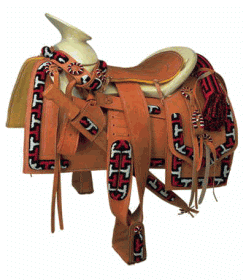 The Western saddle traces its genesis to
Spanish and Mexican influences. These saddles initially came in
to use on cattle ranches and grazing lands where the cowhorse
worked cattle for the vaquero. As cattle ranching spread from
Mexico north, three separate styles of Western saddles evolved.
Geography and the type of cattle influenced this emergence of
different styles of saddle. These working cowhorses and working
cowboys needed tack that made their jobs safer and easier. The Western saddle traces its genesis to
Spanish and Mexican influences. These saddles initially came in
to use on cattle ranches and grazing lands where the cowhorse
worked cattle for the vaquero. As cattle ranching spread from
Mexico north, three separate styles of Western saddles evolved.
Geography and the type of cattle influenced this emergence of
different styles of saddle. These working cowhorses and working
cowboys needed tack that made their jobs safer and easier.
In open areas such as parts of
California, the cowboys worked the cattle by roping them. The
wide-open spaces allowed the cowhorse to line the cowboy up with
a running cow so he could throw a lariat to rope it. The cow
was then dallied to the saddle by the lariat. The dally was
loose so that the horse would not be jerked off its feet or its
withers jarred by the saddle as the running calf hit the end of
the rope.
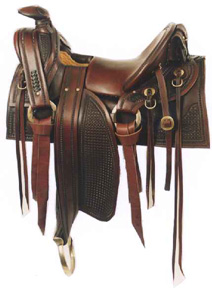 In the Texas brush country,
however, the cowhorse was trained to move the calf out of the
brush by cutting it out of the herd and brush so that the
wrangler could get a good throw. Since the calf was not
generally running, this cowboy roped and tied the calf tight to
the horn. In the Texas brush country,
however, the cowhorse was trained to move the calf out of the
brush by cutting it out of the herd and brush so that the
wrangler could get a good throw. Since the calf was not
generally running, this cowboy roped and tied the calf tight to
the horn.
Besides stout horns for
dallying the ropes with several hundred pounds of calf at the
other end, the Western saddles were developed with the back
cinch. This second cinch kept the saddle in place when the calf
hit the end of the rope and when the cowhorse worked the calf by
taking up the slack as the wrangler dismounted to rope the
calf.
While the Western saddle has a
rich New World Spanish history, it is still evolving today. At
one time, the Western saddle served the cowboy in making his
living. It had to be stout, dependable and designed for the
comfort of the horse and the safety of the rider. Today, the
Western saddles are still ridden for cow working, but a whole
new pleasure industry is demanding a different kind of Western
saddle. Today we will find basically three types of Western
saddles.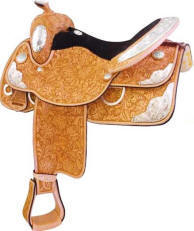
The
Western equitation saddle is designed
for showing or parades. The saddle
is built almost to force the rider into the correct equitation
seat. It is heavily tooled, ornamented with silver
and generally designed to look pretty. While it should
meet the criteria for fit for both rider and horse, it is not a
working saddle and was not designed to hold up to the rigors of
ranch work. A dallied calf would simply rip the horn right
of this type of saddle. The seat is heavily padded and
built up in the front to throw the rider into position.
Swells are medium height.
The
Western Roping Saddle, on the other
hand, is made to stand up to the rigors of
ranch work. It is heavy duty and stout weighing
considerably more than the
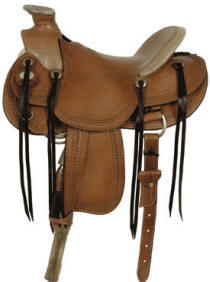 equitation saddles. The horn is
designed to hold a roped calf - at least 3 inches in diameter
and 3 inches high. The swells and cantle of the roping
saddle are low and designed not to interfere with the cowboy's
dismount. equitation saddles. The horn is
designed to hold a roped calf - at least 3 inches in diameter
and 3 inches high. The swells and cantle of the roping
saddle are low and designed not to interfere with the cowboy's
dismount.
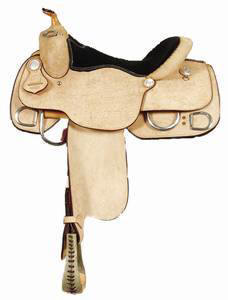
The All Purpose Western
Saddle
is light weight, deep
seated with high swells and cantle to keep the rider secure and
comfortable. Most have a padded seat for long hours on the
trail. The horn is much smaller and less sturdy since the most
that is dallied around it is a canteen or horn bag.
Parts of the Western Saddle
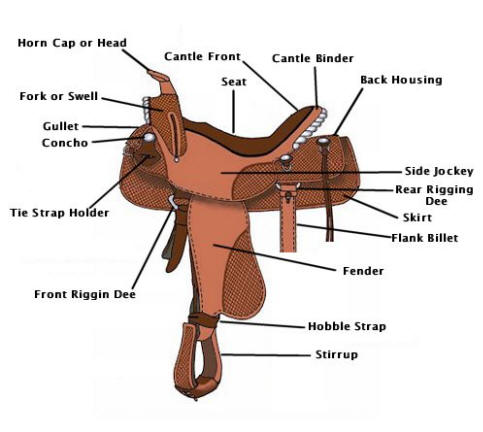 The foundation on which any
saddle is built is the saddle tree. For the western saddle,
traditionally the tree was made from beechwood covered in
rawhide. Given the new materials available, modern trees may be
made from anything from wood to pressed laminated wood to fiber
glass. There are standard trees or you can have one custom made
to fit your mule. The foundation on which any
saddle is built is the saddle tree. For the western saddle,
traditionally the tree was made from beechwood covered in
rawhide. Given the new materials available, modern trees may be
made from anything from wood to pressed laminated wood to fiber
glass. There are standard trees or you can have one custom made
to fit your mule.
If made of wood, the newer
saddles have trees made of plied wood. Plied wood is layered
with the grain placed facing in different directions and glued
under high pressure. This process creates a tree that is warp
resistant and superior in strength to solid wood. The tree is
made up of the fork, the horn, the bars and the cantle.
The gullet and the swells make
up the fork. The gullet is that part which gives shape to the
fork and extends across the withers. The height and width of
the gullet is determined by the width of the mule and the
intended use of the saddle. In most western standard made
saddles the gullet may range from an average of 5 ¾ inches to 6
¼ inches wide and 6 ¾ inches to 8 inches high. If measured from
swell to swell, gullets average 10
2 to 14
inches.
The swell is the shape the
fork takes from the horn down - modified swell fork to undercut
swell fork. The undercut swell fork resembles a pair of horns
on either side of the saddle horn. This allows the rider to
hook a thigh under the swell to maintain stability during a
quick turn. This undercut style is not preferred by ropers who
might catch a rope on it.
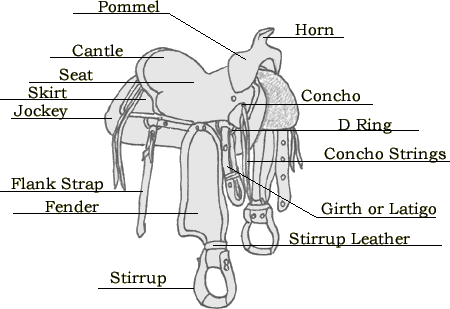
Saddle horns come in a variety
of sizes and materials. Wood, brass, steel or iron can be
covered in smooth leather or rawhide. Horns are attached to the
tree by either bolts or screws and come in types such as
regular, egg-shaped pelican, two rope, high dally or double
dally. Saddle use determines the size, shape and height of the
horn to be put on a saddle. If it's
a roping saddle, the horn will be stout, wide. If it's
a pleasure saddle, the horn will be small in case the rider
needs to grab it for security.
The bars are the part of the
tree that comes in contact with the mule's
back. This is the part that must fit correctly for the optimum
comfort of the mule and correct balance for the rider.
The standard bars include the 5
2 inch Regular, the 6 inch
Semi Quarter Horse, the 6
2 Quarter Horse, the 6 ¾
inch Arab/Morgan. Any other measurement must be custom made.
The cantle rises in the back of the tree and is designed to
keep the rider deep in the saddle. Cantles have different
shapes depending on the work the saddle is designed for.
The configuration of the tree's
parts give the saddle the end silhouette and the best blueprint
for success in the job for which it is intended.
Seats range from flat to built
up, from slick to suede, from small to large. Seat type is the
deciding factor for the comfort of the rider. Each rider will
have his or her preference for the work done in the saddle.
The shape of the seat and the rise from the cantle to the fork
is critical in keeping the rider in the correct position.
Cutters and reiners prefer flat seats that allow the rider more
movement forward and back. Pleasure and trail riders might
prefer a seat that rises steeply from cantle to fork to hold the
rider securely in the seat. This type of seat is also preferred
by the equitation rider because it keeps the rider locked in the
correct position.
Seat measurement is determined by
measuring the distance between the center of the fork across to
the center of the cantle. The rider wants a seat big enough to
allow freedom of movement. It is important that the rider
remain free to move the stirrup leathers freely. Seat sizes
range from 14 ¾ to 15 ¾ inches. When sizing the seat to the
rider, remember to take into account amount of padding, quilting
and rise. All these factors shorten the length of the seat of
the saddle. Remember too short a seat is less comfortable than
too long a seat.
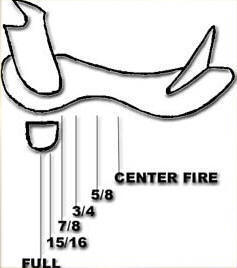 Western Saddle Rigging Western Saddle Rigging
The rigging of a saddle indicates how it is
balanced on the mule's
back and how the girth is attached. As a result of the cattle work
early cowboys had to do, they developed what is called the double
rigging. Double rigging differed from the center fire rigging used
in the English saddles, the old Mexican saddles and the vaquero
saddles, in that it consisted of two rings - one at either end of
the tree.
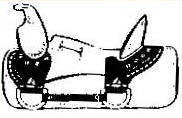 This double rigging, also referred to
as full rigging or rim rigging, provided greater stability to the
saddle and rider as the cowboy roped, stopped and held a couple of
hundred pounds of moving calf. Greater stability meant less trauma
to the horse's
back from the impact of the calf hitting the end of the rope and
jerking the saddle forward. The double rigging is
now the norm in most Western saddles. This double rigging, also referred to
as full rigging or rim rigging, provided greater stability to the
saddle and rider as the cowboy roped, stopped and held a couple of
hundred pounds of moving calf. Greater stability meant less trauma
to the horse's
back from the impact of the calf hitting the end of the rope and
jerking the saddle forward. The double rigging is
now the norm in most Western saddles.
The other types of rigging may be
found in specialty saddles and antique saddles. For today's
pleasure riders who do not rope, the double rigging may seem
cumbersome. It can prove to be uncomfortable for both rider and
mule. The forward cinch has a tendency to rub the mule directly
behind the elbow when the mule or horse is steep shouldered. 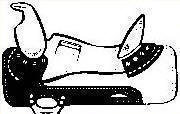 They
are showing interest in a seven-eighths rigging which positions the
front D ring behind the normal position, but still forward of the
center fire point. They
are showing interest in a seven-eighths rigging which positions the
front D ring behind the normal position, but still forward of the
center fire point.
The in-skirt rigging has become
popular with pleasure riders. This rigging has the rings sewn into
the saddle skirting. This type of rigging has minimal bulk under
the rider's
legs, lies closer to the mule and allows the stirrup leathers to
swing more freely. Of course, this type of rigging is not intended
for holding a cow, but is very popular with trail riders, pleasure
riders and those who show their mules.
Some Western saddles come with a
three way rigging which allows the rider to adjust the rigging as
needed. This type of rigging has two slots in it which allows the
rider to choose which slot through which to put the tie strap.
This type of rigging allows for
the many diversities of mules, riders and riding styles. The saddle
purists would quibble with this type of rigging. However, it is
helpful when a rider has a number of mules and does not want to
purchase a saddle with specific rigging for each.
Fitting the Western Saddle
There a two ways to fit the Western saddle to
your mule. One is to have a custom made tree designed for your mule
and the other is to carefully fit the ready made saddle to your
mule. In both cases, the tree is responsible for the comfort of
your mule.
The tree's
bars run along the spine of the mule and spread the weight of the
rider evenly across the mule's
back. The distance between the bars, their flare and their length
affects this weight distribution over the bars.
Regular Bars have a 5
2 inch wide
gullet. They are shaped at a steep angle giving them a narrow
spread. These tend to fit Thoroughbred type mules better.
Semi Quarter Bars have about the
same spread but the gullet is carved out to 6 inches to make the
bars flatter.
The Quarter Horse bars are 6
2 to 6 ¾
inches wide inside the gullet. This bar opens up a bit more to
accommodate the muscular shoulders of the heavier stock mule.
Arabian or Full Quarter Horse bars
are 6 ¾ to 7 inches with flatter angles. This fits the flatter
withered mule better.
In addition, there are saddle
makers who make specialty trees designed for the needs of certain
breeds. Arabian saddles are built for shorter backed animals.
Mules out of Arab and Morgan mares might benefit from this type of
tree.
In order for the fit to be good,
the bars must lay smoothly along the mule's
back. This effectively distributes the rider's
weight evenly along the spine of the mule. Once you cinch up the
saddle, stand two fingers between the mule's
withers and the top of the gullet. If there is not room for your
fingers, the gullet is too wide. If it is too wide, when the rider
puts weight in the saddle and the mule moves, the saddle will hit
the mule on the withers.
The mule's
shoulder must be able to move freely under the bars. To test this
area, slip a hand under the bars of the saddle and have a friend
lead the mule forward slowly. If your fingers get pinched, so will
your mule's
shoulders because
the tree is too narrow.
The bars extend slightly beyond
the point where the cantle is attached to the tree. This provides
support over the mule's
loins and kidneys by distributing the rider's
weight evenly over this tender area of the back. If the saddle
rocks more than an inch from back to front, the bars are not making
good contact and the tree may be too short or too long for the mule's
back.
Keep in mind that a saddle that
fits your mule when he's
two years old may not fit him at six. Saddle fit will be affected
by maturation, weight loss, weight gain and fitness. Even your
custom made saddle may no longer fit as your mule's
back changes as he grows older or becomes more fit. Constantly,
check the fit of your saddle.
In addition, mules inherit
conformation characteristics from both sire and dam. Their back
conformation can be as varied as the breeds of donkeys and horses
used to breed for mules. No two horses are alike. No two mules are
alike.
Fitting the saddle correctly to a
mule's back
is important, not only for the comfort of the mule, but also for the
execution of the maneuver of the job the mule is asked to do. An
ill fitting saddle can be tolerated by most mules. However, if you
want the best for your mule's
comfort and the best performance from your mule, you must have a
correctly fitting saddle. After all, you can't
do your best two step in a tight pair of boots!
|